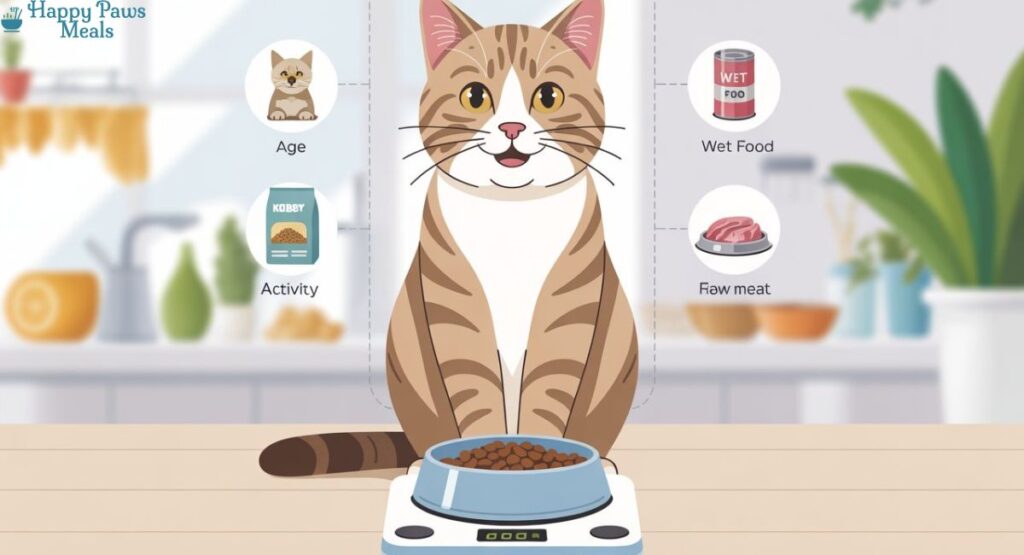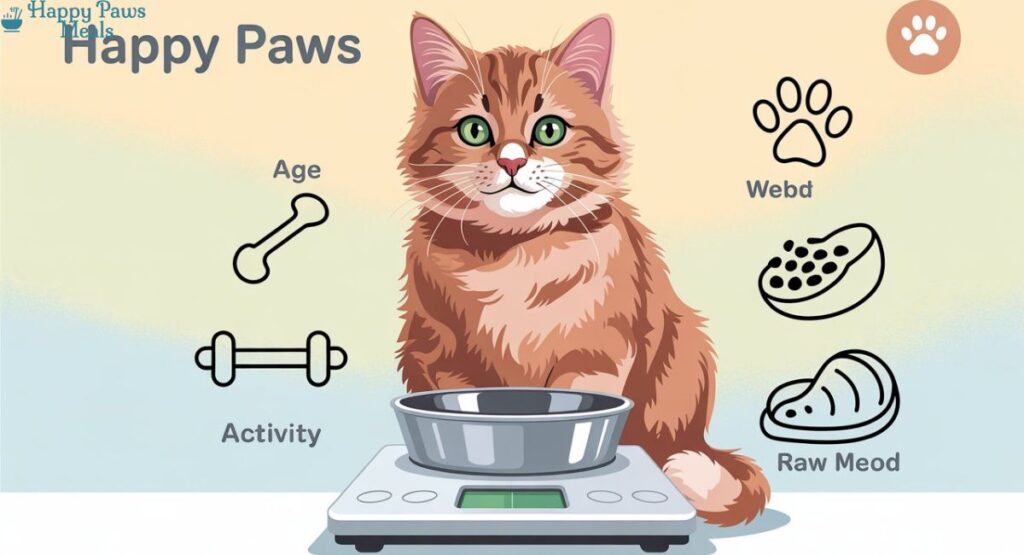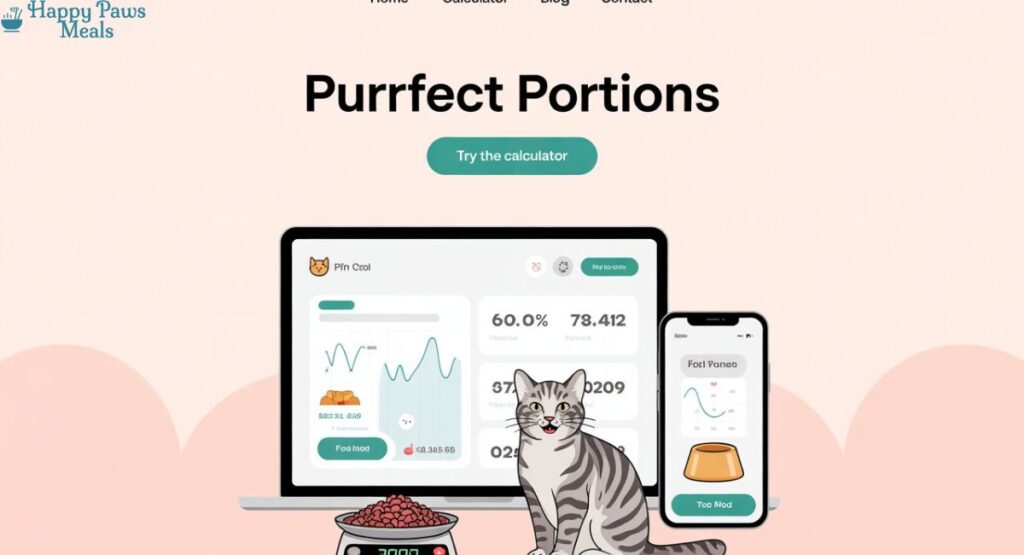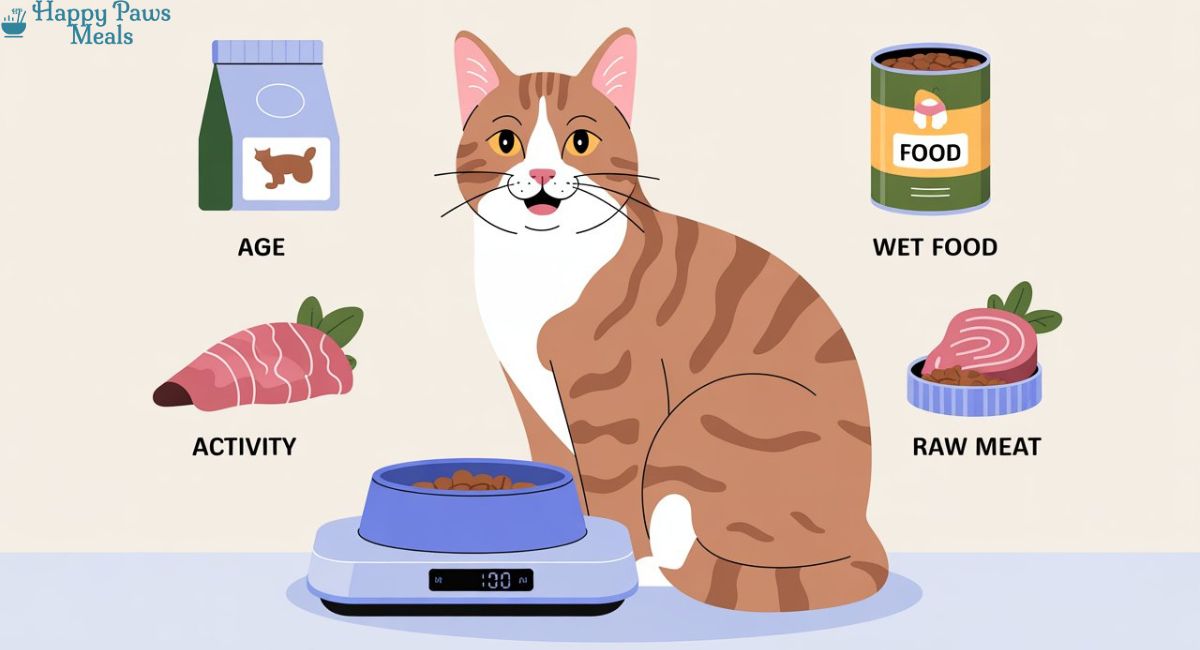Every cat parent wants their furry friend to live a long, healthy, and happy life. One of the most important factors that determine your cat’s overall health is nutrition. But here’s the tricky part—how do you know how much food your cat actually needs? Many owners rely on the instructions printed on the food packaging, but these guidelines are often generic and don’t consider your cat’s unique needs.
That’s where a cat food calculator comes in. This tool helps you determine the exact amount of food your cat needs each day, based on factors such as age, weight, activity level, and health status. Whether you’re feeding dry kibble, wet food, or a raw diet, a cat food calculator gives you personalized feeding guidelines that help prevent obesity, malnutrition, and other diet-related issues.
If you’re looking for food recommendations, check out our detailed guide: Chewy Cat Food: Best Picks for Healthy & Happy Cats in 2026
In this guide, we’ll explore everything you need to know about using a cat food calculator, from how it works to the science behind portion sizes. By the end, you’ll have a clear understanding of how to feed your cat properly and keep them in the best shape possible.
What is a Cat Food Calculator?
A cat food calculator is a tool (online or formula-based) that estimates how much food your cat should eat daily. Instead of guessing or relying only on pet food labels, it uses science-based formulas to calculate daily calorie requirements.

Most calculators take into account:
- Your cat’s weight
- Age (kitten, adult, senior)
- Activity level (indoor vs. outdoor, active vs. sedentary)
- Body condition (underweight, overweight, or ideal weight)
- Food type (wet, dry, or raw food)
By using these inputs, the calculator gives a daily calorie target, which you can then convert into the correct portion of cat food.
How Does a Cat Food Calculator Work?
Behind every cat food calculator is a simple scientific formula. The most common method is calculating the cat’s Resting Energy Requirement (RER).
RER Formula: RER=70×(body weight in kg)0.75RER = 70 \times (body \, weight \, in \, kg)^{0.75}RER=70×(bodyweightinkg)0.75
Once you have the RER, you multiply it by a factor depending on the cat’s life stage or condition. For example:
- Kittens: RER × 2.5
- Adult (neutered, indoor): RER × 1.2–1.4
- Active outdoor cat: RER × 1.6–2.0
- Overweight cat (for weight loss): RER × 0.8
This final number gives the daily calorie requirement, which can be divided into the number of meals per day.

Example:
If your cat weighs 5 kg, RER = 70 × (5^0.75) = ~234 calories.
For a neutered indoor adult cat: 234 × 1.2 = 280 calories/day.
Benefits of Using a Cat Food Calculator
Using a cat food calculator has multiple benefits for both you and your feline companion:
- Prevents Obesity – Overfeeding is one of the leading causes of obesity in cats. A calculator ensures accurate portions.
- Supports Healthy Growth – For kittens, calculators help provide enough calories for rapid growth without overfeeding.
- Custom Feeding – Every cat is unique. The calculator tailors feeding plans instead of using one-size-fits-all packaging.
- Helps Weight Management – If your cat needs to lose or gain weight, the calculator adjusts calorie intake safely.
- Better Digestion – Proper portioning avoids overeating and digestive issues.
- Cost-Effective – Feeding the right amount means your cat food lasts longer and reduces waste.
Factors a Cat Food Calculator Considers
A high-quality cat food calculator doesn’t just look at weight. It considers:
- Weight – Ideal weight vs. current weight.
- Age – Kittens need more calories than seniors.
- Activity level – Indoor cats need fewer calories than outdoor adventurers.
- Breed – Some breeds (like Maine Coons) require more food.
- Health status – Diabetic, obese, or sick cats need special calorie adjustments.
- Type of food – Wet food has fewer calories per gram compared to dry kibble.
Dry Food vs. Wet Food Calculations
Cats can be fed either dry food (kibble), wet food (canned), or a combination of both.
- Dry Food: Higher in calories and more energy-dense. A calculator ensures you don’t overfeed.
- Wet Food: Lower in calories per gram, but higher in moisture, which helps hydration.
- Mixed Feeding: Many calculators allow you to split between wet and dry food.
For example:
280 calories/day could mean:
- 40g dry kibble (150 calories) + 1 wet can (130 calories).
How to Calculate Daily Calorie Needs for Cats
Here’s a step-by-step example:
- Weigh your cat: 5 kg.
- Calculate RER: 70 × (5^0.75) = 234.
- Choose multiplier: Indoor neutered cat = 1.2.
- Daily calorie need = 234 × 1.2 = 280 calories/day.
- Check food label: If dry food is 350 kcal/cup, then 280 ÷ 350 = 0.8 cups per day.
Example Portion Calculations
Kitten (1.5 kg, growing fast):
RER = 70 × (1.5^0.75) = 91 calories.
Multiplier × 2.5 = 228 calories/day.
Adult (5 kg indoor neutered):
RER = 234 calories.
Multiplier × 1.2 = 280 calories/day.
Senior (6 kg, low activity):
RER = 70 × (6^0.75) = 272 calories.
Multiplier × 1.0 = 272 calories/day.
Overweight (7 kg, weight loss):
RER = 70 × (7^0.75) = 320 calories.
Multiplier × 0.8 = 256 calories/day.
Mistakes Cat Owners Make Without a Calculator
- Guessing food portions without considering calories.
- Free-feeding (leaving food out all day).
- Ignoring treats, which add hidden calories.
- Not adjusting for age (kittens vs. seniors).
- Relying only on packaging instead of personalized needs.
Top Online Cat Food Calculators (2026 Update)
Pet parents today are lucky to have access to many free online cat food calculators. Each one works slightly differently, but the goal is the same: to help you figure out your cat’s ideal daily food intake.

Here are some of the most popular:
- Pet Nutrition Alliance Calculator
- Developed by veterinary nutrition experts.
- Considers weight, life stage, and health goals.
- Highly accurate for both dogs and cats.
- Vet-Approved Portion Calculator (PetMD, 2026 update)
- Offers detailed guidelines for kittens, adults, and seniors.
- Also provides feeding advice for overweight or underweight cats.
- Chewy Cat Food Calculator
- Chewy.com now offers an interactive calculator.
- Great for owners who purchase cat food online.
- Can match calorie needs directly with Chewy’s available products.
- Royal Canin & Hill’s Online Tools
- Designed for their own products.
- If you’re feeding these brands, they’re precise and easy to use.
- DIY Spreadsheet Calculators
- Some cat owners build their own in Excel or Google Sheets.
- Good for those feeding raw or homemade diets.
👉 While online tools are helpful, remember they provide estimates. Each cat is unique, so adjustments may be needed.
DIY Cat Food Calculator (Formulas You Can Use at Home)
If you don’t want to rely on online tools, you can make your own cat food calculator.
Step 1: Calculate RER
RER=70×(weight in kg0.75)RER = 70 \times (weight \, in \, kg^{0.75})RER=70×(weightinkg0.75)
Step 2: Multiply by Activity Factor
- Neutered adult cat: ×1.2–1.4
- Active outdoor cat: ×1.6–2.0
- Kitten: ×2.0–2.5
- Weight loss: ×0.8
Step 3: Convert Calories to Portions
Check your cat food label. Example:
- Kibble = 350 kcal per cup
- Wet food = 90 kcal per 3oz can
Divide your cat’s daily calories by the kcal per serving.
Example:
Cat needs 280 calories/day.
If food = 350 kcal per cup → 280 ÷ 350 = 0.8 cups/day.
👉 Pro Tip: Always use a measuring cup or scale. Eyeballing food leads to overfeeding.
Veterinary Recommendations on Cat Feeding
Veterinarians agree that portion control is the single most important factor in feline health. According to the American Veterinary Medical Association (AVMA):
- Over 50% of cats are overweight.
- Obesity increases the risk of diabetes, arthritis, liver disease, and heart issues.
- Feeding guidelines on packaging are often too generous.
Vets recommend:
- Use a cat food calculator as a baseline.
- Monitor your cat’s Body Condition Score (BCS) monthly.
- Adjust portions if your cat is gaining or losing too much weight.
- Feed multiple small meals instead of one large meal.
Cat Food Calculator for Special Diets
Some cats have unique nutritional needs that require more than just standard calculations.
1. Cats with Diabetes
- Require strict calorie control.
- Wet food diets are often preferred.
- A calculator helps prevent spikes in blood sugar.
2. Senior Cats
- Need fewer calories but more protein.
- Calculators adjust for reduced activity and slower metabolism.
3. Overweight Cats
- Calculators allow for gradual calorie reduction.
- Crash diets are dangerous—weight loss should be 1–2% per week.
4. Allergic Cats
- Portion size is critical when feeding hypoallergenic diets.
- Calculators ensure balanced nutrition despite restricted ingredients.
5. Pregnant or Nursing Cats
- Need double or triple calories.
- A cat food calculator helps ensure kittens get enough nutrients through mother’s milk.
Real-Life Examples of Cat Food Calculator in Action
Case 1: Indoor Overweight Cat
- Weight: 6 kg (wants to reduce to 5 kg)
- RER = 70 × (6^0.75) = 272
- Multiplier × 0.8 = 218 calories/day
- Food: 350 kcal per cup → 218 ÷ 350 = 0.62 cups/day
Result: Cat slowly loses weight without starvation.
Case 2: Active Outdoor Cat
- Weight: 4.5 kg
- RER = 70 × (4.5^0.75) = 210
- Multiplier × 1.8 = 378 calories/day
- Food: Wet cans (90 kcal each) → 378 ÷ 90 = 4.2 cans/day
Result: Cat stays energized and lean.
Case 3: Kitten
- Weight: 2 kg
- RER = 70 × (2^0.75) = 118
- Multiplier × 2.5 = 295 calories/day
- Food: Dry kibble 350 kcal/cup → 295 ÷ 350 = 0.84 cups/day
Result: Kitten grows strong with proper calories.
Common Questions About Cat Food Calculators
1. Are cat food calculators accurate?
They are estimates. Use them as a starting point, but adjust based on your cat’s condition.
2. Do calculators work for all food types?
Yes, as long as you know the calories per serving from the label.
3. Should I weigh food or use cups?
Weighing with a kitchen scale is more accurate than cups.
4. Can calculators help with raw diets?
Yes. Just calculate the calories per portion of raw meat and balance it with supplements.
5. How often should I use a calculator?
Use it whenever your cat’s weight, age, or activity level changes.
Extra Tips for Feeding Cats the Right Way
- Always provide fresh water—especially if feeding dry food.
- Avoid giving too many treats (limit to <10% of daily calories).
- Transition food slowly to avoid digestive upset.
- Monitor stool quality—loose stool may indicate overfeeding.
- Reassess calorie needs every 3–6 months.
Why “Free Feeding” is a Problem
Many owners leave a full bowl of kibble out all day, letting cats eat whenever they want. While convenient, this often leads to:
- Overeating and obesity.
- Boredom eating.
- Lack of portion control.
👉 Instead, feed measured meals using your cat food calculator.
Final Thoughts: Why You Should Use a Cat Food Calculator
Feeding your cat isn’t just about filling the bowl—it’s about providing the right amount of nutrition for their body, lifestyle, and health needs. A cat food calculator makes this simple.
By using one regularly, you:
- Prevent obesity and health issues.
- Support your cat’s energy and longevity.
- Save money by avoiding wasted food.
Your cat deserves the best. Start using a cat food calculator today and watch them thrive with proper nutrition.
cat food calculator
I’m Awais Manzoor, the writer behind HappyPawsMeals. With years of interest in pet care and nutrition, I research and review cat and dog food to provide reliable, easy-to-understand advice for pet parents.

